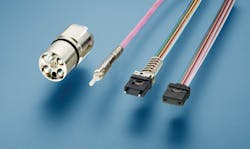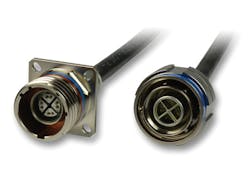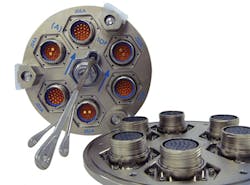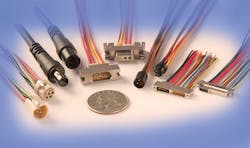Connectors and cables prove critical to modern system designs and upgrades
Military and aerospace engineers focus on cable and interconnect size, weight, cost, and throughput for new and retrofit electronics projects.
By Courtney E. Howard
Military and aerospace engineers, recognizing the criticality of cables and connectors, are weighing cabling and interconnection design considerations and product options early on and throughout workflows today. They also are increasingly meticulous about selecting the optimal cable and connectors, mulling over a lengthy list of application-specific questions and considerations.
Real-world requirements
Connectors and cables in military and aerospace applications strain under a load of requirements, as do the engineers responsible for choosing the correct component for the job. Like the aerospace and defense vehicles and systems that rely on them, cables and interconnects must withstand long life cycles, often spanning many decades; operate in harsh conditions that involve vibration, exposure to saltwater, and temperature extremes; and, in some cases, withstand the wear and tear of repeated plugging and unplugging.
In military and aerospace applications, ruggedization is one of the most important differentiators from interconnects and cables designed for commercial applications, says Tony Padula, product manager at Amphenol Pcd in Beverly, Mass. Military and aerospace interconnects "need to withstand extreme temperatures, vibration conditions, and a variety of different environmental fluids." If designers use interconnects in a wheel well, for example, they come in contact with potentially damaging fluids and chemicals like antifreeze.
Generally speaking, modern military aircraft and unmanned systems have a much more diverse mission than their predecessors, says Mike Savage, director of product management for aerospace and defense at ITT Interconnect Solutions in Irvine, Calif. "They are exposed to a wider variety of environmental conditions, including significant shock, vibration, and extreme temperatures, where they are expected to operate for extended periods."
Also important is the growing need to shield sensitive electrical connections from electromagnetic interference (EMI) and pulse (EMP), as well as electrostatic discharge (ESD), Savage adds. "We're seeing more of this as the spectrum becomes more congested and contested, and electronic and information warfare become more prevalent."
"Military platforms are flying today with more sophisticated onboard sensors than ever before. They often need to transmit high-resolution, multispectral imagery and other kinds of data around the clock," says Savage. "Today's imaging data requirements are in the gigabit range, which means connectors must continually improve to keep ahead of these mission requirements." This trend is driving the demand for higher data rates, and steering product development efforts, resulting in new high-bandwidth, radio-frequency (RF) and data connectors capable of functioning in the multi-gigahertz and multi-gigabit ranges, he adds.
Interconnect considerations
"When selecting mil/aero connectors, one must consider the environment where the cable assembly will be used," says Mike Dabrowski, market director of military/aerospace at Amphenol Fiber Systems International in Allen, Texas. "What are the environmental conditions? Will there be temperature extremes? Does the connector need to be environmentally sealed? Is the environment particularly sandy or corrosive (e.g., seawater)? What are the on-the-ground requirements? Does the connector need to be shock-proof or withstand high-vibration events? Does the connector need to be mated and unmated frequently?"
Performance also is a big consideration. "Is it carrying power and signal? Are there requirements for higher bandwidth? Are there thermal and environmental challenges? The overarching requirements are: what does it have to do and in what environment," asks Earle Olson, business development manager at TE Connectivity in Harrisburg, Pa. "Does it roll, float, or fly, and then whittle it down to discrete aspects, such as the moisture content, like heavy salt fog in naval applications."
When it comes to selecting cable, "a lot of it has to do with the application," says Robert Moore, product development engineer at TE Connectivity. "Temperature rating is key to selection, especially hook-up wire. Wire is sized to the current it is carrying. If the temperature rises, that current will impose on wires carrying power," and from an environmental and safety perspective, can result in smoke, toxicity, and flammability. When we get into data cables - coax or something transmitting high-speed data like Ethernet - it is important to select cable that meets temperature, environmental, fluid resistance, and electrical requirements." In the end, it all has to hook up to connectors and still provide data integrity.
Signal integrity
Integrity is of paramount importance in cable and connector selection, military and aerospace experts agree. "The job of a connector, essentially, is like that of a sensor: to take the signal that comes in and pass it though as purely and cleanly as possible," explains W. Dale Albert, sales director at Amphenol Pcd.
"As speeds go up and voltages decrease, signal integrity design and management is critical to the functions needed in military and aerospace," says Bob Stanton, director of technology at Omnetics Connector Corp. in Minneapolis. Matching the design to the electrical application of the circuit is the key consideration for connector to cable design, he says. "Digital signal quality is more often assured by using differential cable design that matches the impedance of the output and or input system of the processor boards and detectors.
"Proper shield and drain wire interconnections increase the accuracy of the system, and help insure appropriate eye pattern quality of the transmitted signal through the connector and cable assembly and reduce jitter and crosstalk," Stanton adds. "Reduced size, lower weight, and ruggedness immediately follow in the list of important specifications to serve the needs of portable ground troop electronics; airborne equipment, such as unmanned aerial vehicles (UAVs); and satellite systems." Further, military connector designers must seriously plan and implement the use of military pin to socket elements that exceed the minimum requirements of wear during insertion and retraction force.
"Non-military connectors differ predominately in one or more of these considerations," Stanton says. "Most often, I see differences in commercial connectors when designers use connector brands that do not manage pin to socket systems and have low inter-mate strength and poor plating on the pin and socket elements that wear out early."
Cable-run length also is a big consideration. "System-to-system engineers should review carefully the distance from one box to the other and help manage the potential attenuation of smaller, high-speed circuitry in the cable," says Omnetics's Stanton, who also advises planning for electromagnetic interference (EMI) protection that ensures clean lines without noise or even cyber intrusion. "Close proximity can breed crosstalk and skew that will affect signal quality. Mechanical mounting on boards should be tight and clean. New latching micro and nano connectors can help with mating and non-mating."
Military-grade versus commercial
Experts might differ as to which cable and connector characteristics are most important, but many agree that determining whether commercial off-the-shelf components are appropriate for the project is a good first step.
"Comparing mil/aero to commercial connectors and cabling is like comparing tires on a golf cart to tires on a Formula 1 racer. They are a completely different animal," says Pasternack's Rachlin. "The temperatures, pressures, environmental conditions, and mechanical strain are just a few of the areas where mil/aero cables and connectors have much wider and more stringent specifications."
Military vs. commercial has additional considerations. "Where commercial and military needs can differ is that for commercial customers, the goal is to help deliver a more comfortable and enjoyable passenger experience, while the emphasis for military customers often centers on standards and specifications for hardened systems, ruggedness, and performance under more demanding conditions than those typically experienced by commercial aircraft," says ITT Interconnect's Savage.
Interconnects used in aerospace and defense must comply with different specifications than those used to govern commercial interconnects. "The requirements are not always tougher, but they take a different approach," explains Thomas Heller, regional account manager, aerospace and defense, at Molex Inc. in Walldorf, Germany. "Besides customer-specific specifications, there are general aerospace and MIL requirements provided by different authorities," including EN (European), VG (German defense), and Radio Technical Commission for Aeronautics (RTCA) standards.
These specifications reflect different environmental conditions and chemical immersion conditions, as well as different fire, smoke, and toxicity (FST) requirements. On top of this, there are different installation requirements. Since most harnessing and termination operations will be performed inside the aircraft cabin, most interconnect items must be field terminable."
Product engineering teams at ITT Interconnect, for example, are always "working to make connectors standard-ready," Savage says. The company's aluminum and composite Circular Series III connectors are certified to EN3645 in Europe and MIL-DTL-38999 in the U.S., for example. EN3645 certification, which enables the connectors to be used by European original equipment manufacturers (OEMs) and supply chain companies that abide by the EN3645 standard, follows rigorous testing, site audits, and data collection by AeroSpace and Defence Industries Association of Europe - Standardization (ASD-STAN).
Customers increasingly are standardizing around Qualified Products Lists (QPLs), says Amphenol's Albert. Engineers also work closely with industry leaders, including Boeing and Airbus, which have their own standards. Many interconnects are made to an EN, QPL, or European Digital Economy and Society Index (DESI) standard, he says.
"Some customers are lax on standards so they can use commercial off-the-shelf or something lower cost, but there are trade-offs," Albert says. "The engineer has a tough job, figuring out: 'What are the trade-offs in terms of performance and quality if I don't use mil-spec and use a standard off-the-shelf product? Some trade-offs could be: the contact system is less expensive, but not qualified to mil-spec, or plating on the connectors is not Restriction of Hazardous Substances (RoHS)-compliant."
Sometimes a trade-off is unnecessary, so engineers and engineering managers are encouraged to investigate all the available options. "Mil-spec standards have minimum requirements for gold plating - you want it on active areas. To reduce overall costs, choose selectively plated contacts," recommends Amphenol's Padula.
"If you don't see what you are looking for online or in a catalog, do not assume it hasn't already been developed; it may be available," Savage says. "We have done many application-specific designs for customers that can be leveraged for new applications, and it does not necessarily mean significant tooling investments or long lead times. Many technologies exist already and just need to be applied to different connector platforms."
Standards-based selection
Military and aerospace customers typically demand standards-based products, which deliver robustness, reliability, and consistency. "There is an increasingly strong preference toward standards-based solutions and away from vendor proprietary products," Amphenol's Dabrowski says.
The Defense Logistics Agency (DLA), the U.S. Department of Defense's logistics combat support agency at Fort Belvoir, Va., has migrated to SAE Aerospace Standards (AS) from SAE International, which owns ARINC standards, in Warrendale, Pa. "The DLA has a good number of military specifications (mil-specs), and many mass market ones moved to AS," says TE Connectivity's Olson.
"For custom cable assemblies, requirements that we are seeing include NAVSEA S9320-AM-PRO-020/MLDG-certified overmolding," says Dennis Brondi, marketing communications manager at Eaton Aerospace Group in Irvine, Calif. A torpedo-control cable assembly includes a custom connector and a clear NAVSEA-PRO-20-compliant overmold, for example, that provides visual confirmation that all wires are correctly terminated and the overmold is void free."
Some industry standards that began as military specifications have evolved into SAE standards. "From a wire and cable perspective, large OEMs have written specifications for use that were originally mil-spec and are now AS spec," says TE Connectivity's Moore. "SAE over the past year has come out with a standard for high-speed data cables (AS6070)."
Customers also value various cable assembly certifications and compliances - including IPC J-STD-001E, IPC 620, NASA-STD-8739.4, MIS-20887, and MPD-7011 - and are concerned with International Traffic in Arms Regulations (ITAR) technology control plan requirements for weapons-systems applications, Brondi says. For connectors, he and his colleagues see "the usual specification requirements associated with command, control, communications, computers, intelligence, surveillance, and reconnaissance (C4ISR) and weapons-systems applications; e.g., MIL-DTL-38999, MIL-DTL-55116, MIL-STD-1553, etc."
Most customers now require an AS9100-quality system, Amphenol's Drabowski says. In addition to the AS9100 aerospace industry standard, Dabrowski sees standards like Telcordia GR-326, IEC 61300-3-35, and IPC 8497-1 being invoked more frequently on customer specifications. "Customers want to see supporting test data to demonstrate that a product being offered lives up to what the datasheet says it should live up to."
Designers should consider comparing operating environments when looking at standards. "When selecting connectors that are not defined by military specifications, consider including compliance to military specifications for similar-environment solutions as a selection requirement," Eaton's Brondi advises. "For example, since the form factor of the Eaton micro-military connector is a de facto industry standard with no formal military specifications, engineers should consider including supplier-provided qualification reports documenting compliance to MIL-DTL-38999 specifications (including but not limited to: insulation resistance, dielectric withstand voltage, temperature cycling, durability, shock, and vibration) as part of their selection criteria. Supplier-provided qualification reports should also document intermateability with similar connectors from other manufacturers to ensure that the receptacle selected by an electronics OEM will mate with the plug selected by a cable manufacturer."
Test results
A rather long list of mil-specs and application-specific requirements for mil/aero components exist and pertain to the suppliers, facilities, and quality of manufacture of the component, says Pasternack's Rachlin. "ISO 9001 and IQnet certification really provide confidence that the organization you are ordering from is efficient, effective, and has enough credibility to provide the quality of parts and business necessary for mil/aero applications. For mission-critical systems, it is important to know your supplier is experienced and knowledgeable enough to get the orders right, and have the proper testing capability to prove it."
"There also are qualification tests, such as MIL-T-81490 and MIL-DTL-87104, which specify the general requirements for transmission lines and coaxial assemblies," Rachlin says. "Additionally, MIL-STD-202 dictates the requirements for testing electronic and electrical component parts."
In addition to mechanical and environmental requirements, military standards exist for electrical specifications such as radio-frequency (RF) leakage, and power usage on the cable. These requirements are just the tip of the iceberg, Rachlin says. "Most mil/aero applications have their own set of stringent requirements that may exceed the standards. Custom specifications could be mechanical, environmental, or electrical in nature." For these reasons, having sophisticated and certified testing in-house is important for many buyers of cable assemblies.
Size, weight, and speed
When it comes cables and connectors for military and commercial aircraft, "it's all about smaller, lighter, and faster," Savage says. "It's also about cutting fuel costs, reducing the overall weight of the aircraft, increasing safety, and moving to faster and better data networking and data transfer rates." To reduce fuel costs, you must reduce the weight of the aircraft; one of the ways ITT Interconnect has addressed this is to move from aluminum to composite connectors, where appropriate, he says.
Savage is seeing growing demand for high-bandwidth applications that deliver data to pilots and passengers from an increasing variety of on-board sensors and systems, as well as off-board ones, such as satellite or ground-based Internet connectivity.
"To achieve faster data transfer speeds, it's important to understand how data collection and dissemination is changing on modern commercial platforms," Savage says. "High-speed sensing occurs throughout the aircraft, producing data that is sent to the pilot, who views it on a flat, graphical user interface (GUI) or a head-up display (HUD). More data than ever before has to be processed and transmitted visually to the pilot. As a result, bandwidth needs in the cockpit have increased significantly."
Mobile, miniature, and modern
Providers of interconnect technologies are seeing greater demand for ruggedized, miniature connectors to interface with more complicated cable systems designed to handle very fast and clean digital signals.
"From high-speed Ethernet to surveillance cameras and onto portable computers serving helmets, there is a move to highly mobile military systems," Omnetics's Stanton observes. "Hand-launched drones and robotic ground monitoring systems all fit into the new push within military upgrades.
"Older aircraft are being modernized with higher-speed, digital electronic modules replacing older analog systems. The connector and cable systems are designed differently to serve that new era," Stanton adds. "Standard micro and nano connectors are often easily modified to meet that demand and adjusted to fit into smaller, tighter spaces within electronic packages."
As power and high-speed signals combine in reduced size, weight, and power (SWaP) formats, Stanton is seeing newer micro circular cable and connectors using hybrid designs that include 3 to 5 amp pins included in the same housing as multiple sets of high-speed digital interconnections. These hybrids span the design range from miniature rectangular to miniature and nano-miniature circular connectors, he says. For example, rugged, micro circular connectors with very small, flexible wiring are used to route both power and digital signal processing data at speeds up to 3 Gigabits per second from ground soldiers' computers to helmet displays, Stanton says.
Commonality and crossover
Modern aerospace and defense applications are focused on open systems, rather than proprietary solutions. The Vehicular Integration for C4ISR/EW Interoperability (VICTORY) initiative for vetronics, The Open Group technical standard for the Future Airborne Capability Environment (FACE) for avionics, and Hardware Open Systems Technologies (HOST) for shipboard electronics are prime examples of the continuing trend toward open, modular architecture in military and aerospace.
"What was done 20 years ago doesn't work that well today. Gone are the days of purpose-built. A lot of solutions are moving to something more easily applied and easier to handle," to move current technologies to the warfighter faster, explains TE Connectivity's.
Requests for commonality are increasing, says Amphenol's Padula, and there's a focus on boxes and connectors as a fully integrated system. Further, high-speed signals requirements - such as for USB 3.0 and 3.1, and HDMI - are being driven by the telecommunications community and making their way to avionics systems designs. Engineers are driving the industry toward interconnects that are faster, smaller, more lightweight, and higher bandwidth, he explains.
Ongoing upgrades
A lot of radars, especially airborne and shipboard radar, are being upgraded, acknowledges TE Connectivity's Olson. He is seeing "a lot of activity that requires a better solution set," and aerospace and defense organizations performing upgrades "so that systems on board are more capable." Cables and connectors are an integral part of these modernization efforts.
Consolidated Afloat Networks and Enterprise Services (CANES), the U.S. Navy's next-generation tactical afloat network, represents a new business model for delivering capability to the fleet. Many CANES upgrades are implementing fiber-optic data management, including fiber-optic cables and connectors, on DDG-class destroyers. "Everything is being upgraded," Olson says, to deliver more information and a better experience to the end user behind the radar screen.
The end game is to provide military personnel with everything they have come to expect from handheld electronics, like their personal smartphones, Olson explains. Systems "combining data and imaging and full motion video and communications" and "dealing with satellite communications, perishable data, and video all at once. You're not going to do that with standard old MIL-DTL-38999 Series III connectors with 128 contacts; it's just not going to work. That's why you see RF and fiber and power - but not necessarily in one connector, because that's one massive single point of failure."
"Take a system approach," Olson recommends. "Consider the signal path from beginning to end. Be holistic in your thinking. Over the past 35 years, that's one thing that keeps being relearned. Whole platforms will be designed by a cable engineer, connector engineer, and performance engineer and they won't talk to each other. Instead, break it down for everyone involved." It is happening more and more in engineering workflows, he says, and hopefully it is going to continue.
Similarly, engineers are encouraged to communicate and "work with suppliers early and often," Albert explains. "The earlier they can get us involved, the better. It doesn't take one meeting; it takes several iterations. Have an open dialog on what you're trying to accomplish, beyond the cable or interconnect, so we can bring the right solution. If we understand the big picture and where you really want to go step-function-wise, we can position product to save a lot of time and redesign down the road."
Redundant release
Engineers at Eaton Aerospace Group, part of Eaton Corp., in Irvine, Calif., have crafted a redundant-lanyard-release connector designed to meet both aerospace needs and NASA requirements.
"This connector was designed to meet NASA's redundant-release requirements and has also been qualified to facilitate the release of propulsion stages, fairings, crew modules, and parachute covers," says Dennis Brondi, marketing communications manager at Eaton Aerospace Group in Irvine, Calif. Eaton's redundant-release plug incorporates Series III compliant threads and can be used in weapons-system applications, to help facilitate the release of airborne ordinance.
Military vs. commercial considerations
According to Dennis Brondi of Eaton Corp., in addition to environmental and mil-spec compliances, design considerations and differences between military and commercial products include:
- mission criticality, whereby two plates containing mating connector arrays must demate to facilitate separation of the expended first rocket stage from the spacecraft;
- solution complexity in which each connector array comprises 12 connectors and mission defined mixed-mode contact configurations to support signal, data, and power connectivity;
- separation system with force-balanced spring towers and redundant release mechanisms;
- refurbishable and upgradeable designs;
- facilitates reusability and "forward compatibility" as MIL-DTL-38999 derived shells and inserts can be readily changed to support changing mission requirements; and
- program life cycles as long as 30 years.
COMPANY INFO
Airborn Inc.
www.airborn.com
Amphenol Pcd
www.amphenolpcd.com
Amphenol Fiber Systems International
www.amphenol-fsi.com
Eaton Interconnect (formerly Cooper Industries)
www.cooperindustries.com
Digi-Key Electronics
www.digikey.com
Glenair Inc.
www.glenair.com
Harwin
www.harwin.com
HiRel Connectors
www.hirelco.net
ITT Interconnect
www.ittcannon.com
J.A.S. Interconnect
www.jasinterconnect.com
LEMO Connectors
www.lemo.com
Minnesota Wire
www.mnwire.com
Molex Electronic Solutions
www.molex.com
Mouser Electronics
www.mouser.com
Multi-Contact
www.multi-contact.com
Newark Electronics
www.newark.com
Omnetics Connector Corp.
www.omnetics.com
Pasternack
www.pasternack.com
TE Connectivity
www.te.com






